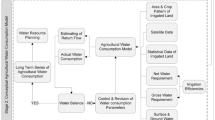Abstract
Water management decisions in irrigation networks are often characterized by complexity, irreversibility and uncertainty. In the present study, an analytical hierarchy model is developed for assessing the Global Water Productivity (GWP) status of irrigation networks. For this purpose 14 criteria, affecting water productivity, and 14 major modern irrigation networks of Iran are analyzed. Dez and Saveh irrigation networks, with the relative weights of 0.112 and 0.045, show the highest and lowest GWP, respectively. The results obtained by the proposed model are evaluated using actual GWP of the irrigation networks from 5-year average field investigations. The results obtained by AHP model are in good agreement with the results determined from the field survey. However, in the proposed model, various mutual exclusive multivariate criteria are considered, offering high qualified final solution and enhancing the consistency of the decision-making process. As the proposed model can identify the effects of different parameters on the GWP of irrigation networks, it is applied as a comprehensive and practical decision-making tool with the aim of improving the performance of such systems.
Similar content being viewed by others
References
Alphonce CB (1997) Application of the analytical hierarchy process in agriculture in developing countries. Agric Syst 53(1):97–112
Bouma J, Brouwer R, van Ek R (2000) The use of integrated assessment methods in Dutch water management: a comparison of cost–benefit and multi-criteria analysis. In: Third international conference of the European society for ecological economics, Vienna, 3–6 May
Bouman BAM (2007) A conceptual framework for the improvement of crop water productivity at different spatial scales. Agric Syst 9(1):43–60
Bottrall AF (1995) Overview: irrigation management research—old themes, new contexts. Water Resour Dev 11(1):5–10
Burt CM, Styles SW (2004) Conceptualizing irrigation project modernization through benchmarking and the rapid appraisal process. Irrig Drain 25(2):145–154
Clemmens AJ, Molden DJ (2007) Water uses and productivity of irrigation systems. Irrig Sci 25:247–261
Expert Choice (2000) Expert Choice software and manual. Expert Choice Inc., 4922 Elsworth Ave., Pittsburgh, PA 15213, USA
Hussain I, Sakthivadivel R, Amarasinghe U, Mudasser M, Molden D (2003) Land and water productivity of wheat in the Western Indo-Gangetic Plains of India and Pakistan: a comparative analysis. IWMI, Colombo, vol VI, 50 p. IWMI Research Report 65
Iranian Water Resources Management Company—IWRMC (2006) Annual information and data on performance assessment of modern irrigation networks (annual report 2002–2006). Ministry of Energy of Iran, Tehran
Kangas J (1993) A multi-attribute preference model for evaluating the re-forestation chain alternatives of a forest stand. For Ecol Manag 59:271–288
Kijne JW, Barker R, Molden D (2003) Water productivity in agriculture: limits and opportunities for improvement. Comprehensive assessment of water management in agriculture series 1. CAB7IWMI. Colombo, Wallingford
Kurttila M, Pesonen M, Kangas J, Kajanus M (2000) Utilizing the analytic hierarchy process (AHP) in SWOT analysis—a hybrid method and its applications to a forest certification case. Forest Pol Econ 1:41–52
Molden DJ, Sakthivadivel R, Perry CJ, de Fraiture C, Kloezen W (1998) Indicators for comparing performance of irrigated agricultural systems. Research report no 20. International Water Management Institute, Colombo
Montazar A, Behbahani SM (2007) Development of an optimized irrigation system selection model using analytical hierarchy process. Biosystems Eng 98:155–165
Munda G (2000) Conceptualising and responding to complexity. In: Spash C, Carter C (eds) Environmental valuation in Europe. Policy research brief, vol 2. Cambridge Research for the Environment, Cambridge
NCCO (2003) Initial national communication to united nations framework convention on climate change. Iranian National Climate Change Office at Department of Environment, Tehran
Okada H, Styles SW, Grismer ME (2008) Application of the analytic hierarchy process to irrigation project improvement. Agric Water Manag 95:199–204
Oki T, Kanae S (2006) Global hydrological cycles and world water resources. Science 313:1068–1072
Omann I (2000) How can multi-criteria decision analysis contribute to environmental policy making? A case study on macro-sustainability in Germany. In: Third international conference of the European society for ecological economics, Vienna, Austria, May 3–6
Perry C (2007) Efficient irrigation; inefficient communication; flawed recommendations. Irrig Drain 56:367–378
Postel S (1992) The last oasis, facing water scarcity. Earthscan, London
Plusquellec HL, McPhail K, Polti C (1990) Review of irrigation system performance with respect to initial objectives. Irrig Drain Syst 4(4):313–327
Raju KS, Kumar DN (2006) Ranking irrigation planning alternatives using data envelopment analysis. Water Resour Manag 20:553–566
Saaty TL (1980) The analytic hierarchy process. McGraw-Hill, New York
Srdjevic B, Medeiros YDP (2008) Fuzzy AHP assessment of water management plans. Water Resour Manage 22:877–894
Varis O (1989) The analysis of preferences in complex environmental judgements, a focus on the analytic hierarchy process. Environ Manage 28:283–294
Vermillion DL (1997) Impacts of irrigation management transfer: a review of the evidence. IIMI research report no 11. IIMI, Colombo
Yang H, Reichert P, Abbaspour KC, Zehnder AJB (2003) A water resources threshold and its implications for food security. Environ Sci Technol 37:3048–3054
Author information
Authors and Affiliations
Corresponding author
Rights and permissions
About this article
Cite this article
Montazar, A., Zadbagher, E. An Analytical Hierarchy Model for Assessing Global Water Productivity of Irrigation Networks in Iran. Water Resour Manage 24, 2817–2832 (2010). https://doi.org/10.1007/s11269-010-9581-4
Received:
Accepted:
Published:
Issue Date:
DOI: https://doi.org/10.1007/s11269-010-9581-4




